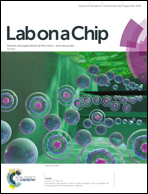Novel devices for studying acute and chronic mechanical stress in retinal pigment epithelial cells
Abstract
Choroidal neovascularization (CNV) is a major cause of blindness in patients with age-related macular degeneration (AMD). Overexpression of vascular endothelial growth factor (VEGF), a potent angiogenic protein, by retinal pigment epithelial (RPE) cells is a key stimulator of CNV. Mechanical stress occurs during different stages of AMD and is a possible inducer of VEGF expression in RPE cells. However, robust and realistic approaches to studying acute and chronic mechanical stress under various AMD stages do not exist. The majority of previous work has studied cyclic stretching of RPE cells grown on flexible substrates, but an ideal model must be able to mimic localized and continuous stretching of the RPE as would occur in AMD in vivo. To bridge this gap, we developed two in vitro devices to model chronic and acute mechanical stress on RPE cells during different stages of AMD. In one device, high levels of continuous mechanical stress were applied to focal regions of the RPE monolayer by stretching the underlying silicon substrate to study the role of chronic mechanical stimulation. In the second device, RPE cells were grown on porous plastic substrates and acute stress was studied by stretching small areas. Using these devices, we studied the effect of mechanical stress on VEGF expression in RPE cells. Our results suggest that mechanical stress in RPE cells induces VEGF expression and promotes in vitro angiogenesis. These results confirm the hypothesis that mechanical stress is involved in the initiation and progression of CNV.

- This article is part of the themed collection: Lab on a Chip Recent HOT Articles


 Please wait while we load your content...
Please wait while we load your content...